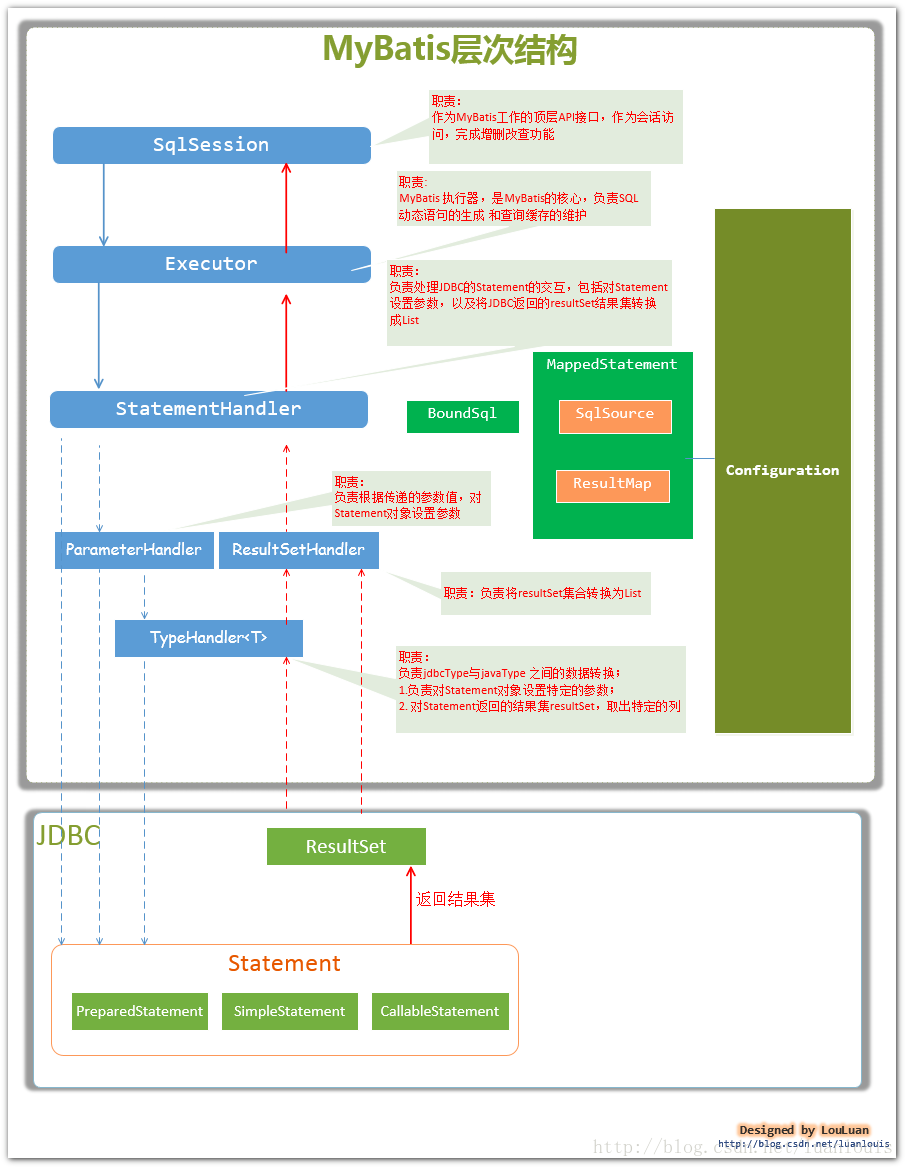1连接池
一 我的错误想法
poolMaximumIdleConnections 最大活跃连接数
poolMaximumActiveConnections 最大空闲连接数
我一直以为
空闲是一直存在的。没请求的时候,活跃回收,空闲连接保持。请求多的时候空闲直接变为活跃,然后生成新的连接直到最大活跃连接数,最大空闲连接数,活跃不断的处理请求,处理完自动销毁。其实是错的。
二 正确想法和源码分析
正确的情况是
没请求的时候,空闲连接每隔一段时间判断其有没有在使用,随时保证空闲的连接健壮性。至于活跃连接会回收,并在回收的时候判断,空闲有没有满,没有就新建个连接给空闲连接,然后设置成不可用,满则直接设置成不可用。
有请求的时候,空闲连接取出到活跃连接,取完空闲就新建连接到活跃连接。而且此时活跃连接完成就会变成空闲连接,再从空闲连接取出到活跃连接执行操作。
我们要知道连接取出来使用popConnection,连接使用完的处理pushConnection。
pushConnection分析
protected void pushConnection(PooledConnection conn) throws SQLException {
synchronized (state) {
//从活跃连接取出
state.activeConnections.remove(conn);
//连接可用
if (conn.isValid()) {
//空闲连接未满,还是期待的连接类型
if (state.idleConnections.size() < poolMaximumIdleConnections && conn.getConnectionTypeCode() == expectedConnectionTypeCode) {
state.accumulatedCheckoutTime += conn.getCheckoutTime();
if (!conn.getRealConnection().getAutoCommit()) {
conn.getRealConnection().rollback();
}
//复制成新连接
PooledConnection newConn = new PooledConnection(conn.getRealConnection(), this);
//放入空闲连接
state.idleConnections.add(newConn);
newConn.setCreatedTimestamp(conn.getCreatedTimestamp());
newConn.setLastUsedTimestamp(conn.getLastUsedTimestamp());
conn.invalidate();
if (log.isDebugEnabled()) {
log.debug("Returned connection " + newConn.getRealHashCode() + " to pool.");
}
state.notifyAll();
} else {
state.accumulatedCheckoutTime += conn.getCheckoutTime();
if (!conn.getRealConnection().getAutoCommit()) {
conn.getRealConnection().rollback();
}
//销毁连接
conn.getRealConnection().close();
if (log.isDebugEnabled()) {
log.debug("Closed connection " + conn.getRealHashCode() + ".");
}
conn.invalidate();
}
} else {
if (log.isDebugEnabled()) {
log.debug("A bad connection (" + conn.getRealHashCode() + ") attempted to return to the pool, discarding connection.");
}
//放入坏的连接
state.badConnectionCount++;
}
}
}
popConnection分析
private PooledConnection popConnection(String username, String password) throws SQLException {
boolean countedWait = false;
PooledConnection conn = null;
long t = System.currentTimeMillis();
int localBadConnectionCount = 0;
while (conn == null) {
synchronized (state) {
//空闲连接集合不是空
if (!state.idleConnections.isEmpty()) {
// Pool has available connection
//从空闲连接取出
conn = state.idleConnections.remove(0);
if (log.isDebugEnabled()) {
log.debug("Checked out connection " + conn.getRealHashCode() + " from pool.");
}
} else {
// Pool does not have available connection
//活跃连接集合还没满
if (state.activeConnections.size() < poolMaximumActiveConnections) {
// Can create new connection
//新建连接
conn = new PooledConnection(dataSource.getConnection(), this);
if (log.isDebugEnabled()) {
log.debug("Created connection " + conn.getRealHashCode() + ".");
}
} else {
//此处活跃连接,空闲连接都满了
// Cannot create new connection
//取第一个活跃连接的状态
PooledConnection oldestActiveConnection = state.activeConnections.get(0);
long longestCheckoutTime = oldestActiveConnection.getCheckoutTime();
//检查时间大于最大检查时间
if (longestCheckoutTime > poolMaximumCheckoutTime) {
// Can claim overdue connection
state.claimedOverdueConnectionCount++;
state.accumulatedCheckoutTimeOfOverdueConnections += longestCheckoutTime;
state.accumulatedCheckoutTime += longestCheckoutTime;
//从活跃连接去掉第一个的连接
state.activeConnections.remove(oldestActiveConnection);
if (!oldestActiveConnection.getRealConnection().getAutoCommit()) {
try {
oldestActiveConnection.getRealConnection().rollback();
} catch (SQLException e) {
log.debug("Bad connection. Could not roll back");
}
}
conn = new PooledConnection(oldestActiveConnection.getRealConnection(), this);
conn.setCreatedTimestamp(oldestActiveConnection.getCreatedTimestamp());
conn.setLastUsedTimestamp(oldestActiveConnection.getLastUsedTimestamp());
oldestActiveConnection.invalidate();
if (log.isDebugEnabled()) {
log.debug("Claimed overdue connection " + conn.getRealHashCode() + ".");
}
} else {
// Must wait
try {
if (!countedWait) {
state.hadToWaitCount++;
countedWait = true;
}
if (log.isDebugEnabled()) {
log.debug("Waiting as long as " + poolTimeToWait + " milliseconds for connection.");
}
long wt = System.currentTimeMillis();
state.wait(poolTimeToWait);
state.accumulatedWaitTime += System.currentTimeMillis() - wt;
} catch (InterruptedException e) {
break;
}
}
}
}
if (conn != null) {
if (conn.isValid()) {
if (!conn.getRealConnection().getAutoCommit()) {
conn.getRealConnection().rollback();
}
conn.setConnectionTypeCode(assembleConnectionTypeCode(dataSource.getUrl(), username, password));
conn.setCheckoutTimestamp(System.currentTimeMillis());
conn.setLastUsedTimestamp(System.currentTimeMillis());
state.activeConnections.add(conn);
state.requestCount++;
state.accumulatedRequestTime += System.currentTimeMillis() - t;
} else {
if (log.isDebugEnabled()) {
log.debug("A bad connection (" + conn.getRealHashCode() + ") was returned from the pool, getting another connection.");
}
state.badConnectionCount++;
localBadConnectionCount++;
conn = null;
if (localBadConnectionCount > (poolMaximumIdleConnections + 3)) {
if (log.isDebugEnabled()) {
log.debug("PooledDataSource: Could not get a good connection to the database.");
}
throw new SQLException("PooledDataSource: Could not get a good connection to the database.");
}
}
}
}
}
if (conn == null) {
if (log.isDebugEnabled()) {
log.debug("PooledDataSource: Unknown severe error condition. The connection pool returned a null connection.");
}
throw new SQLException("PooledDataSource: Unknown severe error condition. The connection pool returned a null connection.");
}
return conn;
}
2.Mybatis,hibernate和hibernate Jpa的对比
MyBatis主要设计目 执行SQL语句时对输入输出的数据管理更加方便,直观体现就是可以手写SQL语句
hibernate主要设计目 加快sql开发,直观体现就是有多个默认的方法,但是复杂的sql支持的不太好
hibernate Jpa结合了两者的优点,既有简单的默认方法·,又可手写sql语句。
3.MyBatis的主要成员
Configuration MyBatis所有的配置信息都保存在Configuration对象之中,配置文件中的大部分配置都会存储到该类中 SqlSession 作为MyBatis工作的主要顶层API,表示和数据库交互时的会话,完成必要数据库增删改查功能 Executor MyBatis执行器,是MyBatis 调度的核心,负责SQL语句的生成和查询缓存的维护 StatementHandler 封装了JDBC Statement操作,负责对JDBC statement 的操作,如设置参数等 ParameterHandler 负责对用户传递的参数转换成JDBC Statement 所对应的数据类型 ResultSetHandler 负责将JDBC返回的ResultSet结果集对象转换成List类型的集合 TypeHandler 负责java数据类型和jdbc数据类型(也可以说是数据表列类型)之间的映射和转换 MappedStatement MappedStatement维护一条<select|update|delete|insert>节点的封装 SqlSource 负责根据用户传递的parameterObject,动态地生成SQL语句,将信息封装到BoundSql对象中,并返回ResultMap
ResultMap 负责返回给用户的parameterObject BoundSql 表示动态生成的SQL语句以及相应的参数信息
简单说就是,先通过Configuration生成配置,初始化了MappedStatement,SqlSource,ResultMap,BoundSql,然后程序调用持久化操作的时候从sqlsession走一遍流程。
图

4.mybatis的缓存
一级缓存是SqlSession级别的缓存,每个SqlSession对象都有一个哈希表用于缓存数据,不同SqlSession对象之间缓存不共享。同一个SqlSession对象对象执行2遍相同的SQL查询,在第一次查询执行完毕后将结果缓存起来,这样第二遍查询就不用向数据库查询了,直接返回缓存结果即可。MyBatis默认是开启一级缓存的。
二级缓存是mapper级别的缓存,二级缓存是跨SqlSession的,多个SqlSession对象可以共享同一个二级缓存。不同的SqlSession对象执行两次相同的SQL语句,第一次会将查询结果进行缓存,第二次查询直接返回二级缓存中的结果即可。MyBatis默认是不开启二级缓存的,要在配置文件中使用配置开启二级缓存
ps.当SQL语句进行更新操作(删除/添加/更新)时,会清空对应的缓存,保证缓存中存储的都是最新的数据。
但是MyBatis的二级缓存对细粒度的数据级别的缓存实现不友好,比如如下需求:对商品信息进行缓存,由于商品信息查询访问量大,但是要求用户每次都能查询最新的商品信息,此时如果使用mybatis的二级缓存就无法实现当一个商品变化时只刷新该商品的缓存信息而不刷新其它商品的信息,因为mybaits的二级缓存区域以mapper为单位划分(mapper文件),当一个商品信息变化会将所有商品信息的缓存数据全部清空。解决此类问题需要在业务层根据需求对数据有针对性缓存(划分不同的mapper文件),具体业务具体实现。
同理和hibernate一样,分布式情况下,这缓存也失效了。